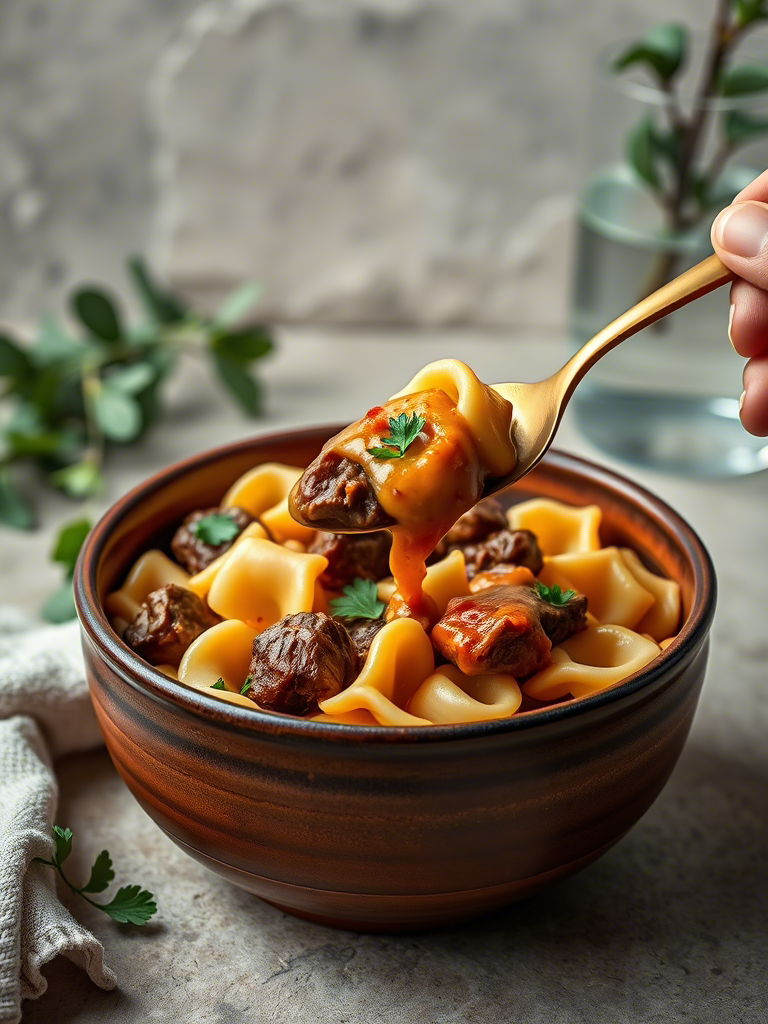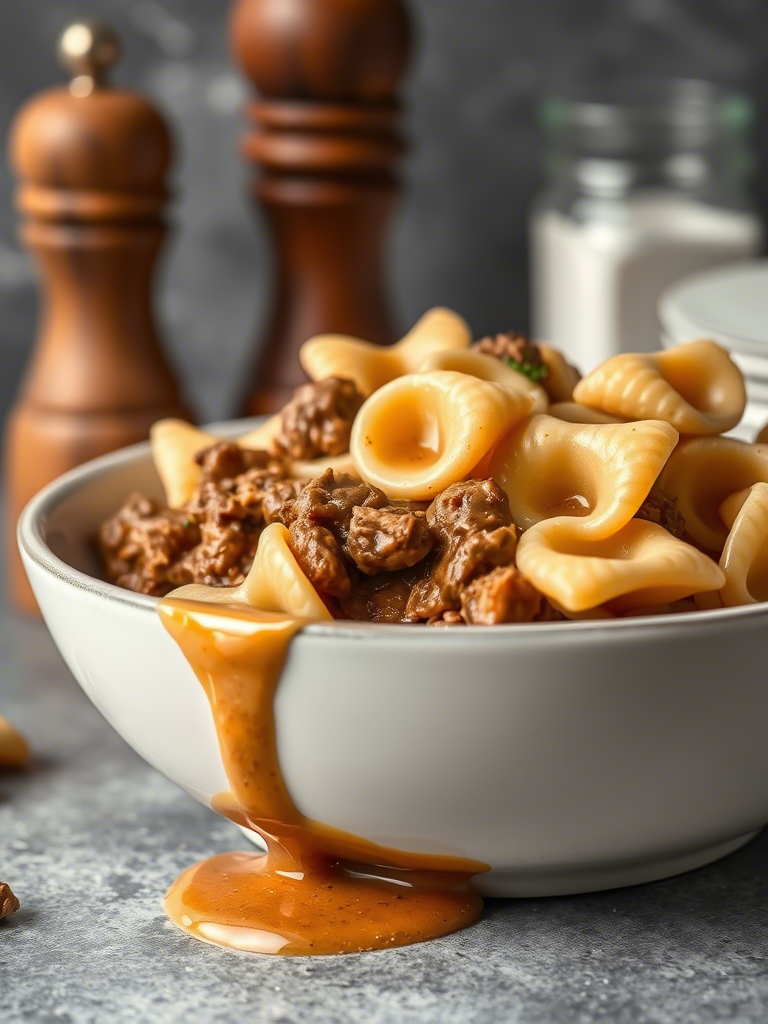There’s something oddly poetic about beef, cream, and pasta dancing together in a hot pan. It’s not just comfort food—it’s chemistry, timing, heat management, and a little sass from the cook. Creamy Beef and Bowtie Pasta might sound like a Tuesday-night dinner, but in skilled hands, it transforms into a layered, textural, umami-laden masterpiece.
If you’re in the culinary game professionally or just flirting with the idea, this dish gives you space to show off. Saucing techniques, texture balance, meat handling—it’s all here. This ain’t some one-pan dump meal. Not if you’re serious.
Let’s dig in and dissect this deceptively simple dish.
Why Creamy Beef and Bowtie Pasta Deserves Respect
The name doesn’t exactly scream Michelin star. But don’t let that fool you. The foundation of this dish touches on four core culinary pillars:
- Protein browning (Maillard reaction, hello)
- Pasta starch control
- Emulsion theory
- Acid-fat balance
Bowtie pasta—or farfalle, for those who wanna sound fancy—brings structure. Those ridged creases are sauce traps. They cradle fat like it’s holy water. Thin sauces get lost on spaghetti; not here. Cream sauce? Stickier than regret.
Beef: It’s Not All Created Equal
First things first, the beef.
Ground chuck, with 80/20 lean-to-fat ratio, is the go-to. Not sirloin. Not that 90/10 dry stuff. You need fat. You need depth. The fat carries flavor through the cream. Without it? You got bland mush.
Sear your beef in batches. Don’t crowd. Brown bits = flavor bombs. Deglaze with white wine if you’re classy, or beef broth if you’re being honest. Never skip that fond—it’s flavor graffiti on your skillet.
Got access to short rib trim or skirt steak scraps? Even better. Hand-chopped beef adds chew and integrity. That’s when this dish steps into restaurant-quality territory.
Pro tip: Add a splash of fish sauce to the beef during browning. You won’t taste fish. You’ll taste wow.
The Cream Sauce: Balance Is Non-Negotiable
This ain’t alfredo. It’s not stroganoff. It’s its own beast.
Start with the beef drippings, butter (unsalted if you’ve seasoned your beef well), and a shallot or two—minced fine, sweated down slowly. Add a tablespoon of tomato paste. It doesn’t make it tomatoey—it adds umami and color.
Deglaze with dry white wine or vermouth. Let it reduce until syrupy. Then—and only then—add heavy cream. At least 36% fat content. Lower fat creams will split under heat or dilute the richness.
Now for the acid. Just a kiss. A teaspoon of white wine vinegar or lemon juice added after the heat’s off will lift the whole thing. Without acid, cream becomes cloying.
Need to thicken? Forget flour. Let the starch from the pasta water do the heavy lifting. It’s silkier, more cohesive, and less grainy.

Bowtie Pasta: Shape Matters, Don’t Laugh
Yes, it’s cute. It’s also functional. Farfalle has structure. The pinched center resists overcooking, while the wings soak in sauce. You get contrast in every bite—al dente core with creamy edges.
Cook in heavily salted water. Think ocean-level salinity. It seasons the pasta from the inside out, which is the only way to do it right.
Boil till it’s 80% done. Then finish it in the sauce. Let it absorb the flavor, not just get coated. Big difference.
And save that pasta water like it’s a family heirloom. You’ll need it to emulsify the sauce later.
Aromatics and Add-Ins: Know When to Shut Up
Here’s where folks mess up. They throw in too much. Mushrooms, spinach, onions, sundried tomatoes, artichokes—stop.
Less is more. You want the beef and cream to star. Add-ins should complement, not compete. A few sliced cremini mushrooms? Fine. A handful of wilted arugula at the end? Fancy. But don’t make it a casserole.
Garlic? Yes. But slice it. Don’t mince it to death. You want it to perfume the dish, not dominate.
Nutmeg? One grate. No more. It’s a whisper in the background, not a scream in your mouth.
Texture: Soft, Chewy, Silky, Snappy
Creamy doesn’t mean mushy. That’s amateur hour.
Contrast matters. Toasted breadcrumbs on top? Crunch. Chopped parsley? Freshness. A dollop of crème fraîche or sour cream? Tang and body.
I once saw a chef fold in crispy pancetta right at the end. Game changer. Crunch, salt, fat—perfect offset to the sauce.
Want to be next-level? Finish the dish with a drizzle of beef jus and a crumble of blue cheese. It turns the humble into haute.
Make It a Menu Star: Plating and Variations
If you’re plating for guests or running a menu, presentation counts.
Use shallow bowls. Spoon a swirl of sauce first, nest the pasta gently on top. Let some beef peek through. Garnish with microgreens, a dust of parmesan, and cracked pepper.
Here’s a twist for fine dining: replace bowties with fresh hand-cut pappardelle. Add sous-vide short rib chunks. Finish with truffle oil. That’s an $18 plate easy.
Or go rustic: serve in a cast-iron skillet, family style, with crusty bread and pickled onions on the side. It’s all about knowing your setting.
Nutrition, Prep Time, and Cost Breakdown
Professionals need numbers. Here’s your cheat sheet.
- Protein per serving: ~25g (if using 6oz beef/person)
- Calories per serving: ~650–800 (depends on cream/beef ratio)
- Prep time: 10 min
- Cook time: 20–25 min
- Food cost (per plate): ~$3.75 (for a mid-range restaurant sourcing decent cream and chuck)
Batch size? Scales well for catering. Just mind your sauce consistency when scaling—larger batches need more emulsification care.
Shelf life? Up to 3 days in cold storage. Reheat gently. Never boil. Cream splits.

Common Mistakes to Avoid
- Boiling the cream sauce – it’ll split. Low simmer only.
- Using lean beef – no fat, no flavor.
- Overcooking pasta – it’ll soak up sauce and turn to goo.
- Neglecting acid – without it, your dish tastes flat and heavy.
- Forgetting to deglaze – that’s flavor suicide.
And please—don’t ever add cold cream straight to hot beef. Temper it. Or you’ll curdle your soul.
A Few Trends to Keep an Eye On
Creamy pastas are making a comeback in upscale casual dining. The 90s are back. Diners are chasing nostalgia, but with better ingredients and cleaner plating.
Beef and cream combos are trending especially with:
- Grass-fed beef for eco-conscious menus
- Cream alternatives like mascarpone or sheep’s milk yogurt for regional flair
- Bowtie and other novelty pastas gaining traction in the TikTok era
People want bold, rich, satisfying—without looking like it came out of a can.
Also? Tableside pasta tosses are huge on social media. Bring a hot skillet to the table and finish it in front of the guest. That sizzle? That steam cloud? It’s edible theater.
Final Takeaways: Respect the Cream, Respect the Heat
Creamy Beef and Bowtie Pasta isn’t fast food. Not when done right. It’s about precision, balance, and respect for ingredients.
Use the good beef. Get the pasta right. Build your sauce slowly. Don’t overcrowd the dish with extras. And finish it with something crisp, bright, or unexpected.
That’s how you turn a humble bowl of pasta into something guests remember. Something they ask about. Something they come back for.
You’re not just feeding people. You’re giving ‘em an experience.
So go make it sing. Or at least sizzle.
And if someone asks you if you made a “fancy Hamburger Helper,” just smile, nod, and let the flavor do the talkin’.
FAQs
What kind of beef is best for creamy beef and bowtie pasta?
Ground chuck (80/20) or hand-chopped beef with good fat content works best for flavor and texture.
Can I use milk instead of heavy cream?
Nope—milk’s too thin and will split; stick with heavy cream (36%+) for a rich, stable sauce.
Why is farfalle (bowtie) pasta recommended?
Its pinched center and ridged wings hold creamy sauces better and give nice bite contrast.
How do I keep the cream sauce from splitting?
Don’t boil it—simmer gently and finish with acid off the heat to keep it smooth.
Can this dish be reheated?
Yes, reheat gently on low heat—never boil, or the sauce will break.
What’s the role of acid in the cream sauce?
Just a dash of lemon or vinegar lifts the richness and prevents the sauce from feeling heavy.
How much pasta water should I save?
About ½ cup is usually enough to emulsify and adjust sauce consistency.
Can I add vegetables to the dish?
Sure, but keep it minimal—think a handful of mushrooms or arugula, not a veggie party.
What’s the best way to plate this for guests?
Use a shallow bowl, swirl sauce first, layer pasta, and garnish with fresh herbs or parmesan.
Is this dish good for restaurant menus?
Absolutely—it’s rich, versatile, easy to upscale, and popular with nostalgia-loving diners.
Ask ChatGPT

Mariana is a passionate home cook who creates delicious, easy-to-follow recipes for busy people. From energizing breakfasts to satisfying dinners and indulgent desserts, her dishes are designed to fuel both your body and hustle.
When she’s not in the kitchen, she’s exploring new flavors and dreaming up her next recipe to share with the Foodie Hustle community.

